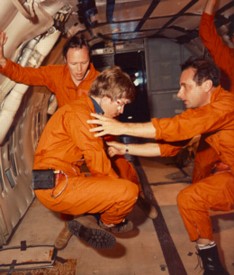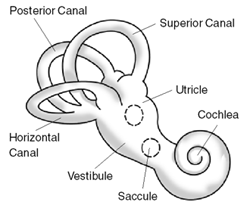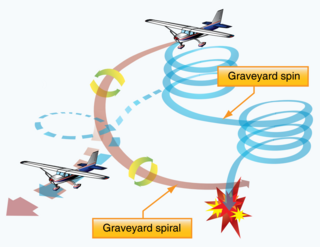Related Research Articles

Motion sickness occurs due to a difference between actual and expected motion. Symptoms commonly include nausea, vomiting, cold sweat, headache, dizziness, tiredness, loss of appetite, and increased salivation. Complications may rarely include dehydration, electrolyte problems, or a lower esophageal tear.

The sense of balance or equilibrioception is the perception of balance and spatial orientation. It helps prevent humans and nonhuman animals from falling over when standing or moving. Equilibrioception is the result of a number of sensory systems working together; the eyes, the inner ears, and the body's sense of where it is in space (proprioception) ideally need to be intact.

The vestibular system, in vertebrates, is a sensory system that creates the sense of balance and spatial orientation for the purpose of coordinating movement with balance. Together with the cochlea, a part of the auditory system, it constitutes the labyrinth of the inner ear in most mammals.

Space adaptation syndrome (SAS) or space sickness is a condition experienced by as many as half of all space travelers during their adaptation to weightlessness once in orbit. It is the opposite of terrestrial motion sickness since it occurs when the environment and the person appear visually to be in motion relative to one another even though there is no corresponding sensation of bodily movement originating from the vestibular system.

Dizziness is an imprecise term that can refer to a sense of disorientation in space, vertigo, or lightheadedness. It can also refer to disequilibrium or a non-specific feeling, such as giddiness or foolishness.
Spatial disorientation is the inability to determine position or relative motion, commonly occurring during periods of challenging visibility, since vision is the dominant sense for orientation. The auditory system, vestibular system, and proprioceptive system collectively work to coordinate movement with balance, and can also create illusory nonvisual sensations, resulting in spatial disorientation in the absence of strong visual cues.

Labyrinthitis is inflammation of the labyrinth, a maze of fluid-filled channels in the inner ear. Vestibular neuritis is inflammation of the vestibular nerve. Both conditions involve inflammation of the inner ear. Labyrinths that house the vestibular system sense changes in the head's position or the head's motion. Inflammation of these inner ear parts results in a sensation of the world spinning and also possible hearing loss or ringing in the ears. It can occur as a single attack, a series of attacks, or a persistent condition that diminishes over three to six weeks. It may be associated with nausea, vomiting, and eye nystagmus.
Airsickness is a specific form of motion sickness which is induced by air travel and is considered a normal response in healthy individuals. Airsickness occurs when the central nervous system receives conflicting messages from the body affecting balance and equilibrium. Whereas commercial airline passengers may simply feel poorly, the effect of airsickness on military aircrew may lead to a decrement in performance and adversely affect the mission.

Benign paroxysmal positional vertigo (BPPV) is a disorder arising from a problem in the inner ear. Symptoms are repeated, brief periods of vertigo with movement, characterized by a spinning sensation upon changes in the position of the head. This can occur with turning in bed or changing position. Each episode of vertigo typically lasts less than one minute. Nausea is commonly associated. BPPV is one of the most common causes of vertigo.

A motion simulator or motion platform is a mechanism that creates the feelings of being in a real motion environment. In a simulator, the movement is synchronised with a visual display of the outside world (OTW) scene. Motion platforms can provide movement in all of the six degrees of freedom (DOF) that can be experienced by an object that is free to move, such as an aircraft or spacecraft:. These are the three rotational degrees of freedom and three translational or linear degrees of freedom.

Vertigo is a condition in which a person has the sensation of movement or of surrounding objects moving when they are not. Often it feels like a spinning or swaying movement. It may be associated with nausea, vomiting, perspiration, or difficulties walking. It is typically worse when the head is moved. Vertigo is the most common type of dizziness.

Human senses are not naturally geared for the inflight environment. Pilots may experience disorientation and loss of perspective, creating illusions that range from false horizons to sensory conflict with instrument readings or the misjudging of altitude over water.

In aviation, a graveyard spiral is a type of dangerous spiral dive entered into accidentally by a pilot who is not trained or not proficient in flying in instrument meteorological conditions (IMC). Other names for this phenomenon include suicide spiral, deadly spiral, death spiral and vicious spiral.

Illusions of self-motion occur when one perceives bodily motion despite no movement taking place. One can experience illusory movements of the whole body or of individual body parts, such as arms or legs.
A sensation of falling occurs when the labyrinth or vestibular apparatus, a system of fluid-filled passages in the inner ear, detects changes in acceleration. This sensation can occur when a person begins to fall, which in terms of mechanics amounts to a sudden acceleration increase from zero to roughly 9.81 m/s2. If the body is in free fall with no other momenta there is no falling sensation. This almost never occurs in real-life falling situations because when the faller leaves their support there are usually very significant quantities of residual momenta such as rotation and these momenta continue as the person falls, causing a sensation of dysphoria. The faller doesn't fall straight down but spins, flips, etc. due to these residual momenta and also due to the asymmetric forces of air resistance on their asymmetric body. While velocity continues to increase, the downward acceleration due to gravity remains constant. Increasing drag force may even cause a feeling of ascent.
The righting reflex, also known as the labyrinthine righting reflex, is a reflex that corrects the orientation of the body when it is taken out of its normal upright position. It is initiated by the vestibular system, which detects that the body is not erect and causes the head to move back into position as the rest of the body follows. The perception of head movement involves the body sensing linear acceleration or the force of gravity through the otoliths, and angular acceleration through the semicircular canals. The reflex uses a combination of visual system inputs, vestibular inputs, and somatosensory inputs to make postural adjustments when the body becomes displaced from its normal vertical position. These inputs are used to create what is called an efference copy. This means that the brain makes comparisons in the cerebellum between expected posture and perceived posture, and corrects for the difference. The reflex takes 6 or 7 weeks to perfect, but can be affected by various types of balance disorders.
The leans is the most common type of spatial disorientation for aviators. Through stabilization of the fluid in the semicircular canals, a pilot may perceive straight and level flight while actually in a banked turn. This is caused by a quick return to level flight after a gradual, prolonged turn that the pilot failed to notice. The phenomenon consists of a false perception of angular displacement about the roll axis and therefore becomes an illusion of bank. This illusion is often associated with a vestibulospinal reflex that results in the pilot actually leaning in the direction of the falsely perceived vertical. Other common explanations of the leans are due to deficiencies of both otolith-organ and semicircular-duct sensory mechanisms.
Space neuroscience or astroneuroscience is the scientific study of the central nervous system (CNS) functions during spaceflight. Living systems can integrate the inputs from the senses to navigate in their environment and to coordinate posture, locomotion, and eye movements. Gravity has a fundamental role in controlling these functions. In weightlessness during spaceflight, integrating the sensory inputs and coordinating motor responses is harder to do because gravity is no longer sensed during free-fall. For example, the otolith organs of the vestibular system no longer signal head tilt relative to gravity when standing. However, they can still sense head translation during body motion. Ambiguities and changes in how the gravitational input is processed can lead to potential errors in perception, which affects spatial orientation and mental representation. Dysfunctions of the vestibular system are common during and immediately after spaceflight, such as space motion sickness in orbit and balance disorders after return to Earth.
Simulator sickness is a subset of motion sickness that is typically experienced while playing video games from first-person perspective. It was discovered in the context of aircraft pilots who undergo training for extended periods of time in flight simulators. Due to the spatial limitations imposed on these simulators, perceived discrepancies between the motion of the simulator and that of the vehicle can occur and lead to simulator sickness. It is similar to motion sickness in many ways, but occurs in simulated environments and can be induced without actual motion. Symptoms of simulator sickness include discomfort, apathy, drowsiness, disorientation, fatigue, and nausea. These symptoms can reduce the effectiveness of simulators in flight training and result in systematic consequences such as decreased simulator use, compromised training, ground safety, and flight safety. Pilots are less likely to want to repeat the experience in a simulator if they have suffered from simulator sickness and hence can reduce the number of potential users. It can also compromise training in two safety-critical ways:
- It can distract the pilot during training sessions.
- It can cause the pilot to adopt certain counterproductive behaviors to prevent symptoms from occurring.
Virtual reality sickness occurs when exposure to a virtual environment causes symptoms that are similar to motion sickness symptoms. The most common symptoms are general discomfort, eye strain, headache, stomach awareness, nausea, vomiting, pallor, sweating, fatigue, drowsiness, disorientation, and apathy. Other symptoms include postural instability and retching. Common causes are low frame rate, input lag, and the vergence-accommodation-conflict.
References
- ↑ Vincoli, Jeffrey W., ed. (2000). Lewis' dictionary of occupational and environmental safety and health. Boca Raton: Lewis Publ. ISBN 978-1-56670-399-4.
- ↑ Sanders, Mark S.; McCormick, Ernest J. (1993). Human factors in engineering and design. McGraw-Hill International Editions Psychology series (Seventh ed.). New York, NY London Madrid: McGraw-Hill. ISBN 978-0-07-112826-1.
- ↑ Ebenholtz, Sheldon M.; Ebenholtz, Sheldon Marshall (2001). Oculomotor systems and perception. Cambridge: Cambridge Univ. Press. ISBN 978-0-521-80459-2.
- 1 2 George Mather (2006). Foundations of perception. Taylor & Francis. ISBN 0-86377-835-6.
- 1 2 3 Fred H. Previc, William R. Ercoline (2004). Spatial Disorientation in Aviation. Reston, VA: American Institute of Aeronautics and Astronautics, Inc. p. 249. ISBN 1-56347-654-1.
- ↑ Bles, Willem; Bos, Jelte E; de Graaf, Bernd; Groen, Eric; Wertheim, Alexander H (1998). "Motion sickness: only one provocative conflict?". Brain Research Bulletin. 47 (5): 481–487. doi:10.1016/S0361-9230(98)00115-4. PMID 10052578.
- ↑ Bles, Willem (1998). "Coriolis effects and motion sickness modelling". Brain Research Bulletin. 47 (5): 543–549. doi:10.1016/S0361-9230(98)00089-6. PMID 10052586.
- ↑ Bles, Willem; Bos, Jelte E; de Graaf, Bernd; Groen, Eric; Wertheim, Alexander H (1998). "Motion sickness: only one provocative conflict?". Brain Research Bulletin. 47 (5): 481–487. doi:10.1016/s0361-9230(98)00115-4. ISSN 0361-9230.
- ↑ Holly, J.E.; McCollum, G. (1996). "The shape of self-motion perception—II. Framework and principles for simple and complex motion". Neuroscience. 70 (2): 487–513. doi:10.1016/0306-4522(95)00355-X. PMID 8848155.
- ↑ Persson, Anders (1998). "How Do We Understand the Coriolis Force?". Bulletin of the American Meteorological Society. 79 (7): 1373–1385. Bibcode:1998BAMS...79.1373P. doi:10.1175/1520-0477(1998)079<1373:HDWUTC>2.0.CO;2. ISSN 0003-0007.
- ↑ "Non-Inertial Systems and Fictitious Forces", An Introduction to Mechanics, Cambridge University Press, pp. 341–372, 2013, doi:10.1017/cbo9781139013963.011, ISBN 978-0-521-19811-0 , retrieved 2024-05-10
- ↑ Bornschein, H.; Schubert, G. (1963). "Der vestibuläre Coriolis-Effekt bei zusätzlicher Linearbeschleunigung". Internationale Zeitschrift für angewandte Physiologie einschließlich Arbeitsphysiologie. 20 (2): 178–189. doi:10.1007/bf00699451. ISSN 1439-6319.
- 1 2 Fernandez, C.; Lindsay, J. R. (1964-10-01). "The Vestibular Coriolis Reaction". Archives of Otolaryngology - Head and Neck Surgery. 80 (4): 469–472. doi:10.1001/archotol.1964.00750040481017. ISSN 0886-4470. PMID 14198713.
- ↑ "CFI Notebook: "Higher" Education". www.cfinotebook.net. Retrieved 2024-05-10.
- 1 2 Davis, Jeffrey R., ed. (2008). Fundamentals of aerospace medicine (4th ed.). Philadelphia: Lippincott Williams & Wilkins. ISBN 978-0-7817-7466-6. OCLC 191751559.
- ↑ Sanderson, Jeffrey; Oman, Charles M.; Harris, Laurence R. (2008-07-03). "Measurement of oscillopsia induced by vestibular Coriolis stimulation". Journal of Vestibular Research. 17 (5–6): 289–299. doi:10.3233/VES-2007-175-609.
- ↑ Arnauld E. Nicogossian (1996). Space biology and medicine. Reston, VA: American Institute of Aeronautics and Astronautics, Inc. p. 337. ISBN 1-56347-180-9.
- ↑ Thomas Brandt (2003). Vertigo: Its Multisensory Syndromes. Springer. p. 416. ISBN 0-387-40500-3.
- ↑ Gilles Clément (2003). Fundamentals of Space Medicine. Springer. p. 41. ISBN 1-4020-1598-4.
- ↑ Demir, Abdurrahman Engin; Aydın, Erdinç (2021-07-30). "Vestibular Illusions and Alterations in Aerospace Environment" (PDF). Turkish Archives of Otorhinolaryngology. 59 (2): 139–149. doi:10.4274/tao.2021.2021-3-3. ISSN 0304-4793. PMC 8329400 . PMID 34386801.
- ↑ "Your Freedom to Fly". www.aopa.org. 2024-11-03. Retrieved 2024-05-10.
- ↑ Conner, Nathan O.; Freeman, Hannah R.; Jones, J. Adam; Luczak, Tony; Carruth, Daniel; Knight, Adam C.; Chander, Harish (2022-11-01). "Virtual Reality Induced Symptoms and Effects: Concerns, Causes, Assessment & Mitigation". Virtual Worlds. 1 (2): 130–146. doi: 10.3390/virtualworlds1020008 . ISSN 2813-2084.